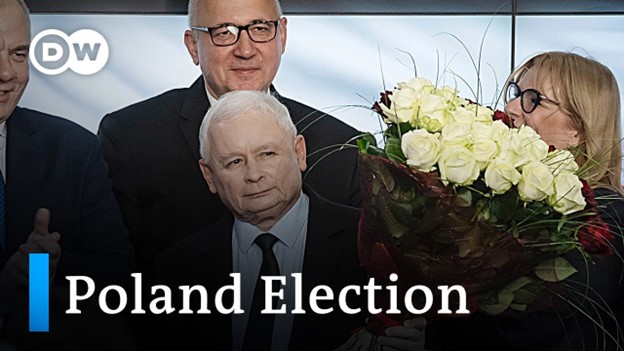“Poland’s Political Landscape Shifts: Law and Justice Party Faces Ouster”

“Poland’s Political Landscape Shifts: Law and Justice Party Faces Ouster”
Poland, a nation at the heart of Europe, stands on the cusp of a significant political transformation. The ruling populists, who have held sway for years, now face a potential electoral setback that could reshape the European political landscape. With the majority of votes tallied, the results paint a promising picture for the opposition led by the charismatic Donald Tusk.
Should this trajectory hold, a Tusk-led government is poised to usher in a new era in Poland’s domestic politics. In recent years, relations between Poland and Brussels have grown strained, largely due to the Law and Justice (PiS) party’s relentless assaults on the independent judiciary and other rule-of-law matters. A change in leadership could herald the dawn of a more cooperative and constructive relationship with the European Union.
The PiS party, while expected to secure the largest share of votes, may find itself in a position of challenge. Donald Tusk’s civic coalition, joined by two other opposition parties, appears to be crafting a path toward a parliamentary majority. This prospect not only heralds a shift in the balance of power but also raises questions about the direction Poland will take in the future.
As the ballots are counted and the winds of change sweep through Poland, the world watches with bated breath. The potential transformation of this key European player could have far-reaching implications, not only within Poland’s borders but also on the European stage. It’s a pivotal moment, a juncture where the destiny of a nation intertwines with the currents of the broader European political landscape.
Donald Tusk, a political heavyweight in Polish history, wasted no time in declaring victory as soon as the polls closed on that fateful Sunday. With confidence emanating from the exit poll results, he boldly proclaimed, “This is the end of bad times, this is the end of the PiS regime,” to rousing cheers from his supporters. Tusk’s triumphant declaration marked the culmination of an era, one that could bring a sweeping change to the political landscape of Poland.
As the hours rolled into Monday evening, the results continued to pour in, painting a clearer picture of the electoral landscape. The ruling Law and Justice (PiS) party garnered 36.1% of the votes, while the Civil Coalition secured 30%, demonstrating a formidable opposition. Meanwhile, the centre-right Third Way and the left-wing Levica stood at 14.4% and 8.4%, respectively. These numbers hinted at the possibility of a coalition forming, which would command more than the 231 seats needed for a parliamentary majority.
give me some important question and answers for this topic”Poland’s Political Landscape Shifts: Law and Justice Party Faces Ouster”
Q1: What factors have contributed to the shift in Poland’s political landscape, leading to the possible ouster of the Law and Justice Party? A1: Explore the factors such as political developments, public sentiment, or policy decisions that have contributed to the shifting political landscape in Poland and the potential ouster of the Law and Justice Party.
Q2: Are there specific policy decisions or controversies involving the Law and Justice Party that have influenced its current standing in Polish politics? A2: Examine any policy decisions or controversies involving the Law and Justice Party that may have contributed to its potential ouster. This could include issues related to governance, rule of law, or international relations.
Q3: How have recent elections or public opinion polls reflected the changing dynamics in Poland’s political scene, particularly concerning the Law and Justice Party? A3: Analyze recent election results or public opinion polls that indicate the changing dynamics in Poland’s political scene, with a focus on the Law and Justice Party’s performance and public perception.
Q4: What opposition parties or political movements are gaining prominence in Poland, and what alternatives do they offer to the current government’s policies? A4: Identify opposition parties or political movements gaining prominence in Poland and explore the alternatives they offer to the policies of the Law and Justice Party. This could involve discussions on their ideologies and policy proposals.
Q5: How has the international community responded to the potential ouster of the Law and Justice Party, and what implications might this have for Poland’s foreign relations? A5: Discuss the international community’s response to the potential ouster of the Law and Justice Party and explore the potential implications for Poland’s foreign relations. This could include diplomatic considerations and geopolitical impacts.
Q6: What role has civil society played in shaping the political landscape in Poland, and how have citizens expressed their views on the Law and Justice Party’s governance? A6: Examine the role of civil society in shaping Poland’s political landscape, particularly in expressing views on the Law and Justice Party’s governance. Consider protests, activism, and citizen engagement.
Q7: Have there been any legal or constitutional challenges related to the Law and Justice Party’s actions, and how might these impact its political standing? A7: Investigate whether there have been legal or constitutional challenges related to the actions of the Law and Justice Party and analyze how these challenges might impact its political standing.
Q8: How is the Law and Justice Party responding to the shifting political landscape, and what strategies are they employing to maintain their position or address opposition? A8: Explore the response of the Law and Justice Party to the shifting political landscape and identify the strategies they are employing to maintain their position or address challenges from the opposition.
Q9: What are the economic implications of the political changes in Poland, and how might they impact the country’s economic policies and stability? A9: Analyze the economic implications of political changes in Poland and discuss how they might impact the country’s economic policies and stability. Consider factors such as foreign investment, fiscal policies, and economic growth.
Q10: How is the media covering and interpreting the developments in Poland’s political landscape, and how might media influence public perception of the situation? A10: Examine how the media is covering and interpreting the developments in Poland’s political landscape. Consider the role of media in shaping public perception and influencing the narrative surrounding political changes.

